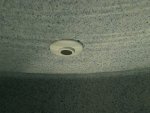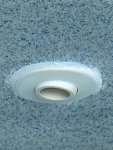Recently I have been losing a lot of water, about 1” daily from my pool. Doing some investigation with some phenol red in a syringe I found that water is being lost around one of the return jet fittings. Not from the plumbing but the area where the body of the fitting meets the pool surface. The dye very quickly is getting sucked in. All the other jets seem fine. There is also a small area of missing surface around the jet. (See photo). Not sure what exactly the surface is but it’s a textured concrete type of pool. Maybe gunnite? Should I try sealing around the body of the jet with an underwater epoxy? Or bring in an expert to look at it?
Leak around return jet
- Thread starter Jdhaenen
- Start date
You are using an out of date browser. It may not display this or other websites correctly.
You should upgrade or use an alternative browser.
You should upgrade or use an alternative browser.
I would try a underwater epoxy first. One of the best is, A+B Epoxy Putty, 7Oz, White 9904H: Amazon.com: Industrial & Scientific
- Jun 22, 2014
- 47,726
- Pool Size
- 17888
- Surface
- Fiberglass
- Chlorine
- Salt Water Generator
- SWG Type
- CircuPool RJ-45 Plus
Make sure to research all the products you review closely. Many products advertise as "underwater", but must be applied dry first before submerging. In addition, you can expect most epoxy products to dry hard, so future removal may result in breaking something apart. When I was doing some research before for a similar situation, I came across the item below which seemed like a viable option. Maybe @jimmythegreek had another thought.
Amazon.com : Underwater Magic Leakage Preventor, White : Patio, Lawn & Garden
Amazon.com : Underwater Magic Leakage Preventor, White : Patio, Lawn & Garden
www.amazon.com
thanks for the comments. I didn’t see the 2nd response before I got the A+B putty and did the cleanest fix I could do. Seems to work like a charm, pool has not lost anything in the last 24 hours. Very happy since I was having nightmares about the possible scenarios with the plumbing.
Attachments
Make sure to research all the products you review closely. Many products advertise as "underwater", but must be applied dry first before submerging. In addition, you can expect most epoxy products to dry hard, so future removal may result in breaking something apart. When I was doing some research before for a similar situation, I came across the item below which seemed like a viable option. Maybe @jimmythegreek had another thought.
Amazon.com : Underwater Magic Leakage Preventor, White : Patio, Lawn & Garden
Amazon.com : Underwater Magic Leakage Preventor, White : Patio, Lawn & Gardenwww.amazon.com
BTW I am wondering if maybe following the methodology here lead to the issue. I am thinking that maybe this leak existed since the build of the pool and over time the leak slowed due to algae or other buildup through the area. This just became noticeable to me after doing SLAM and keeping my chlorine at a consistently higher level since with the stenner pump than I had been able to achieve with tablets in the past. Anyway my pool looks great now and I’m not having to add water every other day so I’m happy.
- Nov 12, 2017
- 11,819
- Pool Size
- 12300
- Surface
- Plaster
- Chlorine
- Salt Water Generator
- SWG Type
- Pentair Intellichlor IC-40
Ha, ha! I was wondering just the other day if there were any posts or threads describing how the TFP method didn't work. I couldn't recall ever seeing one. I was trying to make a point about the TFP success rate to someone. And now there is one!! "TFP worked so well that it cleaned up all the algae in my pool and that resulted in a leak!" 
I sometimes am lazy about fixing minute plumbing leaks in my copper plumbing because I know, here where I live, the minerals in my hard water will eventually plug up very small holes. I can't imagine algae doing something similar, but I suppose anything is possible. But I think you already identified the cause. The seal of plaster to plumbing was not done all that well originally, and it finally gave out. Glad you were able to get it fixed!
I sometimes am lazy about fixing minute plumbing leaks in my copper plumbing because I know, here where I live, the minerals in my hard water will eventually plug up very small holes. I can't imagine algae doing something similar, but I suppose anything is possible. But I think you already identified the cause. The seal of plaster to plumbing was not done all that well originally, and it finally gave out. Glad you were able to get it fixed!
Well I wouldn’t go that far saying it didn’t work  . The other possibility is my calcium hardness has been low after replacing some water a while back so maybe some deposits that were slowing the leak got eroded. I’m bringing that up slowly although my CSI has overall been where it should be. Right now it’s at -.02
. The other possibility is my calcium hardness has been low after replacing some water a while back so maybe some deposits that were slowing the leak got eroded. I’m bringing that up slowly although my CSI has overall been where it should be. Right now it’s at -.02
- Nov 12, 2017
- 11,819
- Pool Size
- 12300
- Surface
- Plaster
- Chlorine
- Salt Water Generator
- SWG Type
- Pentair Intellichlor IC-40
Look at you! SLAM this and CSI that, underwater repairs!! You got your pool down!! Nice work. 
Thread Status
Hello , This thread has been inactive for over 60 days. New postings here are unlikely to be seen or responded to by other members. For better visibility, consider Starting A New Thread.



